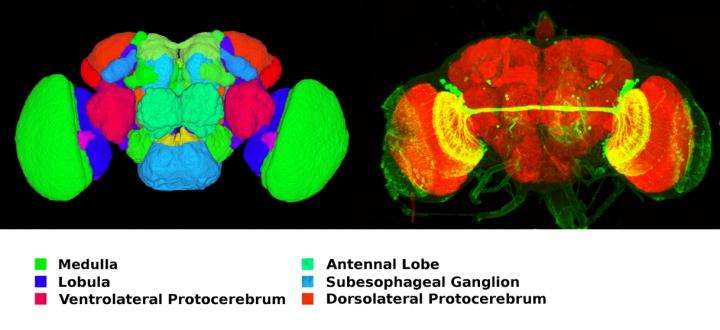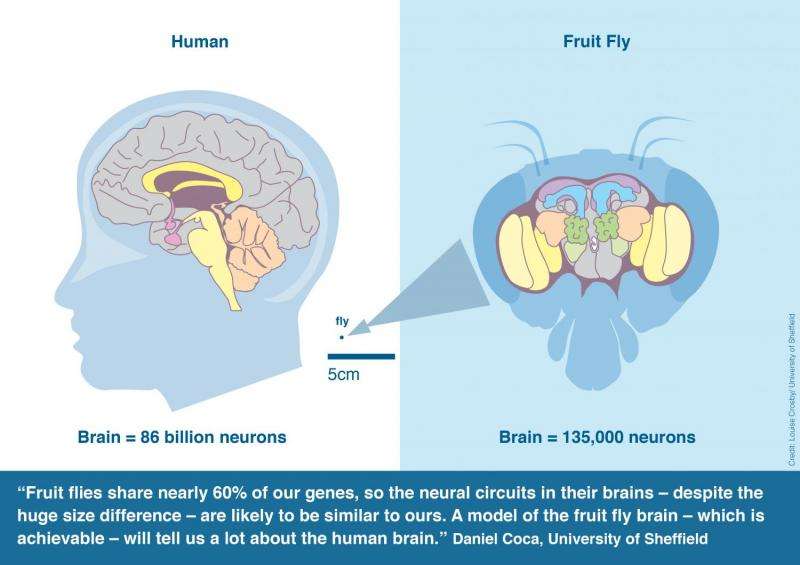Researchers launch collaborative project to build first complete fly brain model

Researchers at the University of Sheffield have launched an ambitious project to simulate a complete model of the adult fruit fly brain for the first time.
The team is developing an open software platform that will enable researchers from around the world to contribute data, models and tools to construct a comprehensive model of the fruit fly (Drosophila) brain. By working collaboratively, the model can be built far more rapidly and efficiently than would be possible by teams working independently.
Because many of the genes and proteins found in the human brain are also found in the fruit fly's brain, a complete model could provide insights that will help develop a better understanding of diseases such as Alzheimer's or motor neurone disease as well as help identify potential new drug targets.
"The collaborative software platform that we are developing will enable the research community to focus their efforts and build a biologically plausible model of the fruit fly brain faster, by integrating the knowledge available from different scientific communities across the world," says Daniel Coca, Professor of Nonlinear & Complex Systems at the University of Sheffield and UK project leader.

Funded jointly by the Biotechnology and Biological Sciences Research Council UK and the National Science Foundation in US, the £1.2 million project is a partnership between researchers at the University of Sheffield, Columbia University in the City of New York, research laboratories at Stanford, Washington, Oxford and National Tsing Hua Universities, as well as NVIDIA, the company that pioneered GPU computing.
The fruit fly is one of the most popular model organisms to study neural computation and for relating brain structure to function. Its brain has many functional similarities with our own and it exhibits a wealth of complex behaviours that can be experimentally probed using a powerful toolkit of genetic techniques.
Because the fruit fly brain has just 135,000 neurons, compared to around 86 billion in the human brain, it poses a far less formidable computational challenge. The scientists believe that a 'first draft' model of the brain, which will incorporate existing models of the neural circuits and synaptic connections maps, could be build and simulated in the coming decade.
"Several huge projects are currently underway to provide complete models of the human brain, but these won't be complete for many years to come. We believe these projects will benefit enormously from an understanding of how smaller brains work," says Aurel Lazar, Professor of Electrical Engineering at Columbia University and US Project Leader.
In order to simulate such a complex system, the software will harness the computational power afforded by the massively parallel computational capability of NVIDIA's Graphics Processing Units (GPUs).
"Modelling of neural systems at the individual neuron level creates an enormous computational challenge. Utilising power efficient and highly parallel GPUs will enable us to scale simulations to biologically credible sizes, giving real insight into emergent biological processes. " says Dr Paul Richmond, Vice-Chancellor Research Fellow at the University of Sheffield and Co-Investigator on the project.
"This ambitious project will advance important science while demonstrating again the versatility and sheer computational horsepower that GPU computing delivers," says Dr David Luebke, NVIDIA Distinguished Inventor & Senior Director of Research. One of the major objectives of the project is the development of a web-based portal that will provide access to the simulation framework, data
and model repositories, collaborative tools for model development, sharing and review as well as community-led discussion forums. Ultimately, the portal will provide an environment that accelerates model development, nurtures discussions, collaborations and further research.


















